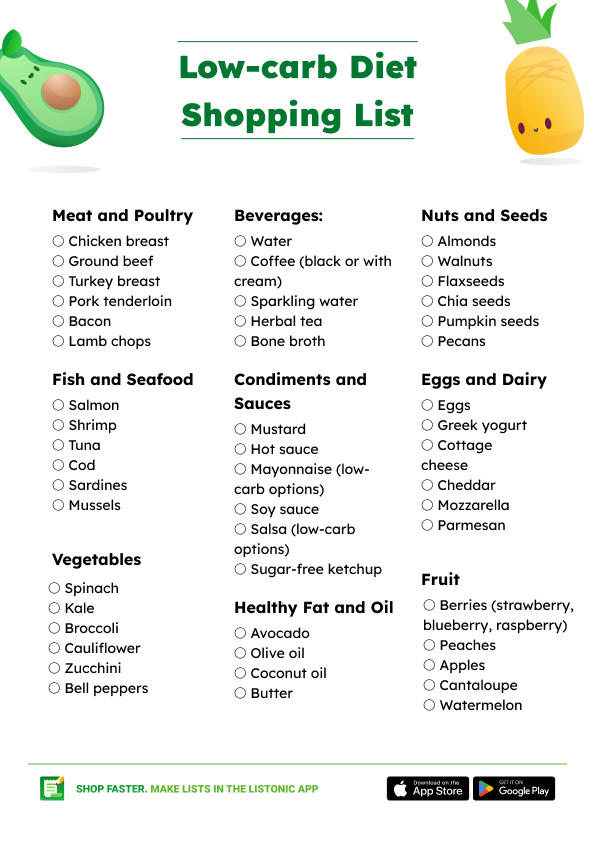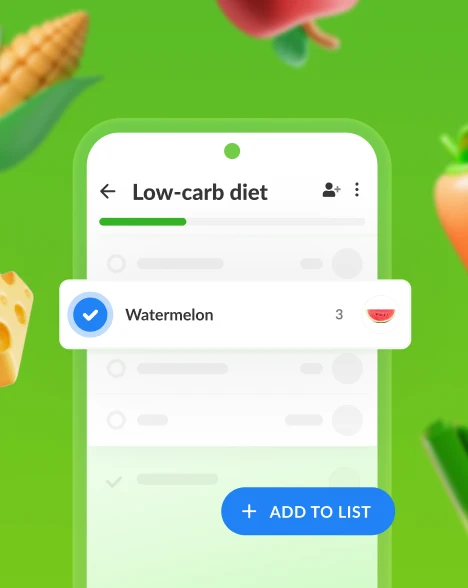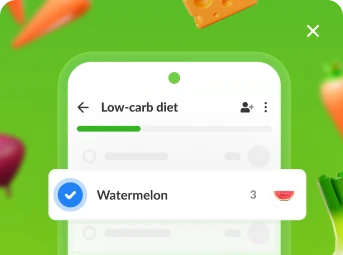Privacy Policy | Terms of services | Consent choices | © 2006-2024 Listonic. All rights reserved. Listonic Dev, and Listonic Ads are part of Listonic.

Low Carb Diet Food List (+ Shopping List and PDF)
January 22, 2025
Start your journey to a healthier lifestyle with our comprehensive guide to the low carb diet. This article covers the basics, benefits, and key rules of this dietary plan. Learn how to reduce your carb intake and incorporate nutrient-packed foods for improved well-being. To make it even easier, we’ve included a handy shopping list for 2025 (with a downloadable PDF) to help you get started on the right track.
Table of contents
Low Carb Diet Shopping List
Low Carb Diet Guidelines
Low Carb Diet Food List Breakdown
What Else to Keep in Mind?
Conclusions
Low Carb Diet Shopping List
Meat and Poultry
Fish and Seafood
Eggs and Dairy
Vegetables
Nuts and Seeds
Healthy Fat and Oil
Condiments and Sauces
Fruit
Beverages
Snacks
Low Carb Diet Guidelines
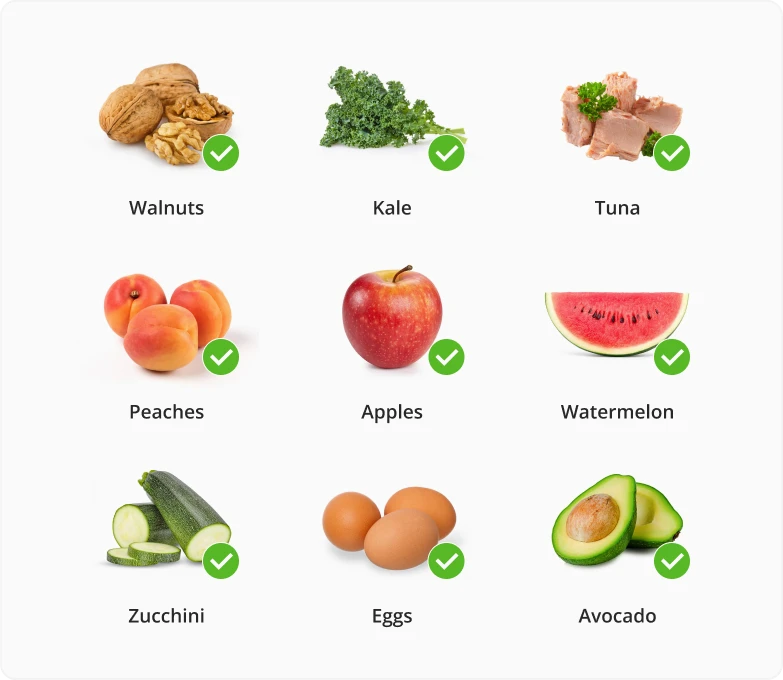
A low-carb diet can be a great way to improve your health and manage your weight. By following these 2025 guidelines, you can create a balanced and satisfying eating plan that will help you achieve your goals.
Firstly, it’s important to minimize carbohydrate-rich foods. This means cutting back on bread, pasta, rice, and sugary treats. Instead, opt for nutrient-dense alternatives like vegetables, lean protein, and healthy fats.
Speaking of protein, prioritize lean sources such as meat, poultry, fish, eggs, and dairy products. These will not only help you feel satisfied but also support muscle health.
When it comes to fats, choose healthy options like avocados, olive oil, coconut oil, and nuts. These provide energy and satiety without the drawbacks of unhealthy fats.
Don’t forget to load up on fiber-rich vegetables. Spinach, kale, broccoli, and bell peppers are excellent choices as they not only provide essential nutrients but also promote digestion.
Be cautious of hidden carbs in condiments, sauces, and processed foods. Always read labels carefully to ensure that you’re not unknowingly consuming more carbs than you intended.
Staying hydrated is crucial, so make sure to drink plenty of water, herbal tea, and coffee without added sugars.
Lastly, planning and preparing meals ahead of time can greatly support your low-carb goals. This allows you to have control over the ingredients and portion sizes, making it easier to stick to your eating plan.
By following these guidelines, you can enjoy a satisfying and nutritious low-carb diet that will help you achieve your health and weight management goals. Remember to listen to your body and make adjustments as needed to find what works best for you.
Low Carb Diet Food List Breakdown
Meat and Poultry
Meat and poultry are staple foods in a low-carb diet due to their high protein content and minimal carbohydrates. Chicken breast, turkey breast, pork tenderloin, ground beef, bacon, and lamb chops are all excellent choices. They can keep you satiated and provide the necessary building blocks for muscle growth and repair.
Eggs and Dairy
Eggs and dairy products are low in carbs and provide high-quality protein, vitamins, and minerals. Eggs are a versatile option and can be cooked in various ways. Greek yogurt (unsweetened), cottage cheese, cheddar cheese, mozzarella cheese, and Parmesan cheese are also low-carb dairy choices. These foods can be included in a low-carb diet to increase protein intake and add flavor to meals.
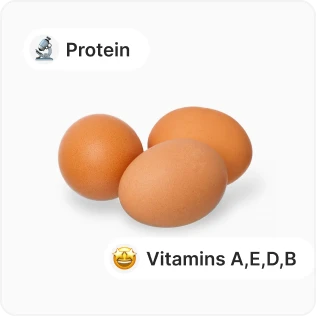
Fish and Seafood
Fish and seafood are rich in protein, healthy fats, and various essential nutrients while being low in carbs. Salmon, shrimp, tuna, cod, sardines, and mussels are all great choices for a low-carb diet. They offer omega-3 fatty acids, which are beneficial for heart health, and are generally low in calories. Incorporating fish and seafood into a low-carb diet adds variety and helps meet protein and nutrient requirements.
Vegetables
Vegetables are a vital component of a low-carb diet as they provide essential nutrients, fiber, and antioxidants while being relatively low in carbs. Spinach, kale, broccoli, cauliflower, zucchini, and bell peppers are low-carb vegetables that offer a range of vitamins and minerals. They can be incorporated into meals as side dishes, stir-fries, salads, or used as alternatives to high-carb ingredients like pasta or rice.
Nuts and Seeds
Nuts and seeds are excellent sources of healthy fats, protein, fiber, and various vitamins and minerals. While they contain some carbohydrates, they are generally low in net carbs due to their high fiber content. Almonds, walnuts, flaxseeds, chia seeds, pumpkin seeds, and pecans are all suitable options for a low-carb diet. They can be enjoyed as a snack or used as toppings in salads, yogurt, or other low-carb dishes.
Healthy Fat and Oil
Healthy fats and oils are a crucial part of a low-carb diet as they provide energy, support nutrient absorption, and help maintain satiety. Avocado, olive oil, coconut oil, butter, and ghee are all low-carb options. These fats can be used in cooking, salad dressings, or as spreads, adding flavor and richness to meals while keeping carb intake in check.
Get a Low Carb Diet Grocery List on Your Phone!
Add & remove items
Sort items by store aisles
Share the list with your partner
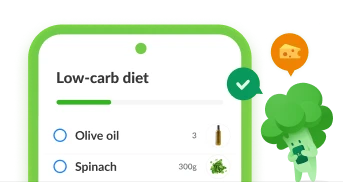
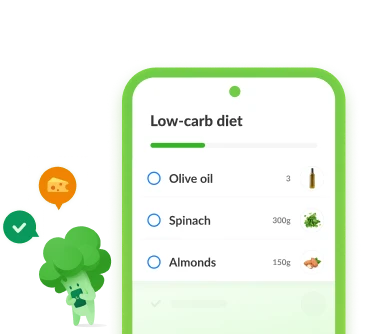
What Else to Keep in Mind?
What Foods to Avoid?
On a low-carb diet, it's important to avoid or significantly limit certain types of foods that are high in carbohydrates. Here are some foods you should generally avoid or minimize:
Grains: This includes bread, pasta, rice, cereals, and other grain-based products. These foods are typically high in carbs and can spike your blood sugar levels.
Sugary treats: Candy, cookies, cakes, pastries, and other sugary snacks should be avoided. They are loaded with refined sugars and provide little to no nutritional value.
Starchy vegetables: Some vegetables contain higher amounts of carbohydrates. Potatoes, sweet potatoes, and corn are examples of starchy vegetables that should be limited.
Sugary beverages: Sodas, fruit juices, energy drinks, and sweetened teas are high in sugar and can quickly increase your carb intake. It's best to stick to water, unsweetened tea, or coffee.
Legumes: While legumes such as beans, lentils, and chickpeas are generally considered healthy, they are also relatively high in carbohydrates. If you're following a strict low-carb diet, it's recommended to limit your consumption of legumes.
High-carb fruits: Some fruits, such as bananas, grapes, and tropical fruits like pineapples and mangoes, are higher in carbs compared to berries. If you choose to include fruits, opt for lower-carb options like berries in moderation.
Processed foods: Many processed foods, including packaged snacks, frozen meals, and fast food, often contain hidden carbs in the form of added sugars, refined grains, and fillers. It's essential to read labels and avoid these products as much as possible.
Who Should Follow the Low-carb Diet?
The low-carb diet can be followed by various individuals depending on their health goals and medical conditions. Here are some groups of people who may benefit from a low-carb diet:
Individuals with obesity or weight management goals: Low-carb diets can be effective for weight loss and weight management. By reducing carb intake and focusing on nutrient-dense foods, individuals can experience improved satiety, better blood sugar control, and enhanced fat burning.
Individuals with type 2 diabetes or prediabetes: Limiting carbohydrates can help regulate blood sugar levels in people with diabetes or prediabetes. A low-carb diet can potentially reduce the need for diabetes medication, improve insulin sensitivity, and better manage blood glucose levels.
Individuals with metabolic syndrome: Metabolic syndrome is a cluster of conditions that often includes high blood pressure, elevated blood sugar levels, excess abdominal fat, and abnormal cholesterol levels. Low-carb diets may help improve these metabolic markers and reduce the risk of heart disease.
Individuals with polycystic ovary syndrome (PCOS): PCOS is a hormonal disorder that can cause weight gain, insulin resistance, and irregular menstrual cycles. A low-carb diet may help manage insulin levels, regulate hormonal imbalances, and support weight loss in individuals with PCOS.
Individuals with epilepsy: The ketogenic diet, a very low-carb and high-fat diet, has been used for decades to help reduce seizures in children and adults with epilepsy who don't respond well to medication alone.
Individuals seeking to improve cardiovascular health: Low-carb diets can help reduce triglyceride levels, increase HDL (good) cholesterol, and lower blood pressure, all of which are beneficial for heart health.
Athletes and individuals looking for improved athletic performance: Some athletes and active individuals adopt low-carb diets to optimize their body composition, enhance endurance, and improve metabolic flexibility.
Side Effects of the Low-carb Diet
While a low-carb diet can have numerous benefits, it's important to be aware of potential side effects that some individuals may experience:
Initial discomfort: Some people may experience initial side effects during the adjustment period, often referred to as the "low-carb flu." These can include fatigue, headache, dizziness, irritability, and difficulty concentrating.
These symptoms are usually temporary and can be minimized by ensuring proper hydration and electrolyte balance.
Nutrient deficiencies: Restricting certain food groups may lead to inadequate intake of certain nutrients, such as fiber, B vitamins, and minerals like magnesium and potassium. It's essential to carefully plan a low-carb diet to ensure it includes a variety of nutrient-rich foods or consider supplementation if needed.
Digestive issues: A sudden increase in dietary fat and reduction in fiber-rich carbohydrates may cause digestive discomfort, such as constipation or diarrhea, in some individuals. Gradually increasing fat intake and ensuring adequate fiber from low-carb vegetables can help alleviate these issues.
Social challenges: Following a low-carb diet can be challenging in social settings where high-carb foods are commonly served. It may require extra planning and communication to ensure there are suitable options available.
Conclusions
To sum it up, a low-carb diet can be a game-changer for your health and weight management journey. By cutting down on carbs and opting for nutritious alternatives, you can shed those extra pounds, regulate your blood sugar levels, and boost your overall health in 2025 and beyond. Just keep in mind that you might experience some initial adjustments and side effects, but don't worry, they're temporary.
To help you navigate the low-carb diet, we have included a ready-to-use grocery list that you can download in a PDF format or open in our free shopping list app on your phone.
Embrace the low-carb lifestyle, and you'll be on your way to a healthier, happier you.

